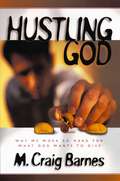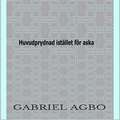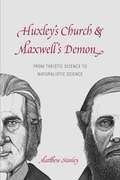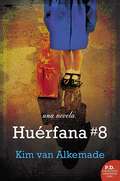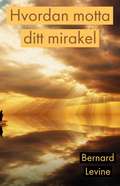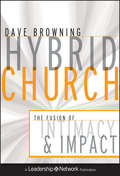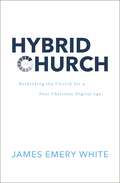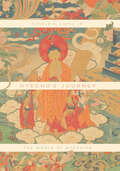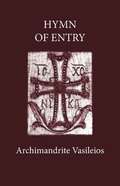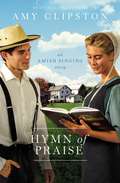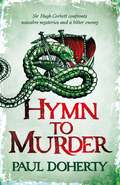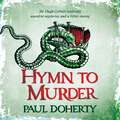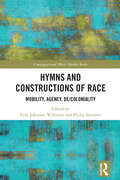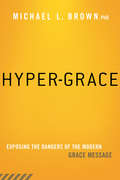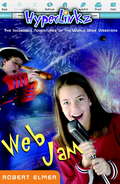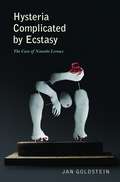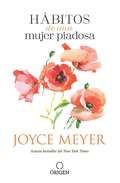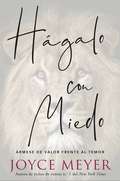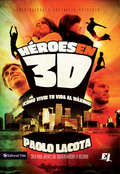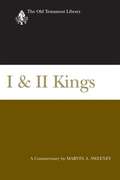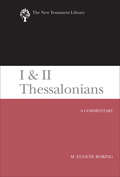- Table View
- List View
Hustling God: Why We Work So Hard for What God Wants to Give
by M. Craig BarnesWe work hard at life. We try to get better jobs, better homes, better relationships, and even a better spirituality. We are like Jacob in the Old Testament. His name means "striver, schemer, supplanter, hustler." He could have been the poster boy for the American Dream. But author Craig Barnes says this is not the way we should be living our lives. We should not try to manipulate and hustle ourselves into a place of advantage with God, a position that has been ours all along. After all, God is the one who climbed down the ladder to be with us. Using true anecdotes from the men, women, and families of the churches he has served, Barnes invites hard-running, stressed-out, burned-out people to stop striving. Life is not something we grasp and clutch to us, but a gift God freely gives. Only when we open our hands can God fill them with the blessings he has been waiting to lavish upon us all along.
Huvudprydnad istället för aska
by Gabriel AgboEn av dygderna som alltid och för evigt uppmuntrar troende att hålla fast vid Gud, även inför en till synes extrem hopplöshet och förtvivlan, är Hans förmåga att ändra de mest obehagliga förhållanden till fördelaktiga vittnesbörd. Du kanske har gjort allt i din mänskliga makt för att komma ur en specifik situation, till ingen nytta. Tyvärr verkar allt dina ansträngningar gav dig vara sorg, smärta, ånger, sorg, skam och tårar. Det är då som att du kan frestas att ifrågasätta Guds kärlek, eller rentav hans existens. Gör inte det, inte än. Läs den här boken först. Gud är fortfarande den som ger oss huvudprydnad istället för aska.
Huxley's Church and Maxwell's Demon: From Theistic Science to Naturalistic Science
by Matthew StanleyDuring the Victorian period, the practice of science shifted from a religious context to a naturalistic one. It is generally assumed that this shift occurred because naturalistic science was distinct from and superior to theistic science. Yet as Huxley’s Church and Maxwell’s Demon reveals, most of the methodological values underlying scientific practice were virtually identical for the theists and the naturalists: each agreed on the importance of the uniformity of natural laws, the use of hypothesis and theory, the moral value of science, and intellectual freedom. But if scientific naturalism did not rise to dominance because of its methodological superiority, then how did it triumph? Matthew Stanley explores the overlap and shift between theistic and naturalistic science through a parallel study of two major scientific figures: James Clerk Maxwell, a devout Christian physicist, and Thomas Henry Huxley, the iconoclast biologist who coined the word agnostic. Both were deeply engaged in the methodological, institutional, and political issues that were crucial to the theistic-naturalistic transformation. What Stanley’s analysis of these figures reveals is that the scientific naturalists executed a number of strategies over a generation to gain control of the institutions of scientific education and to reimagine the history of their discipline. Rather than a sudden revolution, the similarity between theistic and naturalistic science allowed for a relatively smooth transition in practice from the old guard to the new.
Huérfana # 8
by Van Alkemade KimUna fascinante novela debut de ficción histórico del mundo olvidado de los orfanatos judíos de la ciudad de Nueva York.En 1919, Rachel Rabinowitz, de cuatro años de edad, es colocada en el Hogar Infantil Hebreo donde el doctor Mildred Solomon está llevando a cabo una investigación médica en niños. El doctor Solomon somete a Rachel a un proceso experimental con rayos X que establece la reputación del doctor mientras pone en peligro la salud de la niña. Ahora es 1954, y Rachel es enfermera en el hospicio del Hogar Infantil Hebreo para ancianos donde el doctor Solomon se convierte en su paciente. Se da cuenta del poder que tiene sobre el doctor indefenso, Rachel se embarca en un experimento peligroso de su propio diseño. Antes que termine el turno de la noche, Rachel estará obligada a elegir entre el perdón y la venganza.Inspirada en hechos reales, este libro es una poderosa novela sobre la capacidad humana para lastimar y amar.
Hvordan motta ditt mirakel
by Bernard LevineDenne boken er en spennende bok som vil gjøre deg veldig glad når du begynner å oppdage livets hemmeligheter, lykke og suksess. Vær tro mot deg selv og følg ditt hjerte. La miraklene du lengter etter, begynne å komme inn i livet ditt!
Hybrid Church
by Dave BrowningA hands-on resource for both large and small churches It has been predicted that in the twenty-first century extremely large churches would emerge in America that resemble neither an elephant nor a field of mice. Which is better? At one time the answer would have been either/or. Now it's both/and. We want both the intimacy of smallness and the impact of bigness-we want a hybrid of the two. Hybrid Church is a practical guide for clergy and leaders who want to have the best of both church worlds: the intimacy of small "house church" groups and the impact of very large mega-churches. Offers a guide for churches who want to capitalize on their strengths to build intimacy with impact Written by the pastor of one of the "fastest growing" and "most innovative" churches in America with thousands of members organized in small house groups Outlines a vision for how the church of tomorrow could look like the early church. Given that the trend is toward very large and very small, with few churches in the middle, this book will be a welcome resource for both large and small churches.
Hybrid Church: Rethinking the Church for a Post-Christian Digital Age
by James Emery WhiteWe live our lives in both physical and digital community.We need to do ministry the same way.Because of COVID-19, nearly every church in the US was forced to adapt to a quarantine and adopt new ministry strategies, including digital technologies they may have avoided before. When services began to be offered in-person once more, many church leaders said they hoped they'd never have to "live stream" again for the rest of their lives. But then came the shock: people didn't return in droves, and declining attendance steepened. The pandemic had only accelerated the profound cultural changes that were already marginalizing the church and reducing its relevance.In Hybrid Church, James Emery White argues that the post-pandemic church must commit to a hybrid strategy as the only means to reach a post-Christian culture in a digital age.This book will help you rethink the church's approach and stretch you to move beyond the mentality of "that's the way we've always done it." First outlining the dynamics and depths of the new realities we face, White then walks you through major ways of rethinking digital community, strategic thinking, discipleship, and outreach—tackling practical topics like:How to create an online presence that removes unnecessary barriers to engagement and community.How to rethink your church's delivery, both online and in-person.How to meet the spiritual and communal needs of a younger, digitally-native generation.How to shift from a focus on gathering and attendance to a more biblical vision of togetherness and discipleship. Hybrid Church is written to enable pastors and church leaders to see the positive opportunities in the radical changes of the day and to help model a dynamic new approach to ministry.
Hyderabad, British India, and the World
by Eric Lewis BeverleyThis examination of the formally autonomous state of Hyderabad in a global comparative framework challenges the idea of the dominant British Raj as the sole sovereign power in the late colonial period. Beverley argues that Hyderabad's position as a subordinate yet sovereign 'minor state' was not just a legal formality, but that in exercising the right to internal self-government and acting as a conduit for the regeneration of transnational Muslim intellectual and political networks, Hyderabad was indicative of the fragmentation of sovereignty between multiple political entities amidst Empires. By exploring connections with the Muslim world beyond South Asia, law and policy administration along frontiers with the colonial state and urban planning in expanding Hyderabad City, Beverley presents Hyderabad as a locus for experimentation in global and regional forms of political modernity. This book recasts the political geography of late imperialism and historicises Muslim political modernity in South Asia and beyond.
Hyecho's Journey: The World of Buddhism
by Donald S. Lopez Jr.In the year 721, a young Buddhist monk named Hyecho set out from the kingdom of Silla, on the Korean peninsula, on what would become one of the most extraordinary journeys in history. Sailing first to China, Hyecho continued to what is today Vietnam, Indonesia, Myanmar, India, Pakistan, Afghanistan, and Iran, before taking the Silk Road and heading back east, where he ended his days on the sacred mountain of Wutaishan in China. With Hyecho’s Journey, eminent scholar of Buddhism Donald S. Lopez Jr. re-creates Hyecho’s trek. Using the surviving fragments of Hyecho’s travel memoir, along with numerous other textual and visual sources, Lopez imagines the thriving Buddhist world the monk explored. Along the way, Lopez introduces key elements of Buddhism, including its basic doctrines, monastic institutions, works of art, and the many stories that have inspired Buddhist pilgrimage. Through the eyes of one remarkable Korean monk, we discover a vibrant tradition flourishing across a vast stretch of Asia. Hyecho’s Journey is simultaneously a rediscovery of a forgotten pilgrim, an accessible primer on Buddhist history and doctrine, and a gripping, beautifully illustrated account of travel in a world long lost.
Hymn of Entry: Liturgy and Life in the Orthodox Church
by Archimandrite VasileiosTheology, as seen by Archimandrite Vasileios, is by its very essence liturgical; it is not a philosophy or a system but the expression of the church's mystical life: "The first Christians lived their theology totally and with the whole of their bodies, just as they are baptized with the whole of their body and soul into the new life...Thus their liturgical gatherings were an initiation into the mystery of theology...The mystery of theology was celebrated in their lives, and they attained to the knowledge which is eternal life." Bishop Kallistos (Ware) states in his foreword: [Hymn of Entry] offers nothing less than a fresh vision of theology, the church and the world, a vision that is both original and yet genuinely traditional. The quality that characterizes this remarkable book is above all a sense of wholeness. The unity of the divine and human in the incarnate Christ, the unity of heaven and earth in the Divine Liturgy, the unity between theology and spirituality, between theology and life - such are the author's master-themes.
Hymn of Praise: An Amish Singing Story
by Amy ClipstonAn Amish Singing story from bestselling author Amy Clipston.Sharon Lambert and Jay Smoker have been friends for a long time, but lately Jay has seen Sharon in a new light. They begin spending time together, and Sharon invites Jay to her family&’s home to serve dinner and to sing traditional hymns for their English guests. When Jay decides that this tramples upon his doctrinal beliefs, can these two dear friends compromise and find love? Or will Jay&’s strict views keep them apart?
Hymn of the Universe
by Pierre Teilhard De ChardinIn this book it is almost always Pere Teilhard, the man of prayer rather than the man of science, who speaks to us. As Sir Julian Huxley wrote of The Mass on the World, it is a 'truly poetical essay ... at one and the same time mystical and realistic, religious and philosophical'. This does not mean, of course, that the author ever forgets or betrays his science; what it does mean is: that the reader's approach, and response, to these pages must of necessity be quite different from those demanded by the scientific works. The mystic, the poet use language in a way essentially different from that of the scientist.
Hymn to Murder (Hugh Corbett 21)
by Paul DohertyHugh Corbett returns in the twenty-first gripping mystery in Paul Doherty's ever-popular series. If you love the historical mysteries of C. J. Sansom, E. M. Powell and Bernard Cornwell you will love this.Secrets simmer in the lonely wasteland of Dartmoor. Spring, 1312. At Malmaison Manor, Lord Simon is concealing a dark secret - one he arrogantly assumes will never catch up with him. But someone knows about the crime he committed and they've found a way to make him pay. And he's not alone. When he is found mysteriously slain, other deaths soon follow. Meanwhile, ships on the Devonshire coast are being deliberately wrecked, their crews slaughtered, their cargoes plundered. Sir Hugh Corbett and Lord Simon are bound by the Secret Chancery and their search for one precious ruby - the Lacrima Christi. So, when Corbett learns of Lord Simon's death, he is once more dragged into a tangled web of lies and intrigue and it's not long before secrets of his own start to surface. As the Hymn to Murder reaches its crescendo, can Corbett confront his past and live to see another day? Praise for Paul Doherty's dark and suspenseful novels:'His fascination for history comes off the page' Daily Express 'An opulent banquet to satisfy the most murderous appetite' Northern Echo 'Deliciously suspenseful, gorgeously written and atmospheric' Historical Novels Review 'Paul Doherty has a lively sense of history . . . evocative and lyrical descriptions' New Statesmen
Hymn to Murder (Hugh Corbett 21)
by Paul Doherty1312. The shadows around the English Crown grow ever darker in the twenty-first instalment of the much-loved Hugh Corbett series by Paul Doherty. An enthralling medieval mystery not to be missed by fans of C. J. Sansom, E. M. Powell and Bernard Cornwell.Hugh Corbett returns in the twenty-first gripping mystery in Paul Doherty's ever-popular series. If you love the historical mysteries of C. J. Sansom, E. M. Powell and Bernard Cornwell you will love this.Secrets simmer in the lonely wasteland of Dartmoor.Spring, 1312. At Malmaison Manor, Lord Simon is concealing a dark secret - one he arrogantly assumes will never catch up with him. But someone knows about the crime he committed and they've found a way to make him pay. And he's not alone. When he is found mysteriously slain, other deaths soon follow. Meanwhile, ships on the Devonshire cost are being deliberately wrecked, their crews slaughtered, their cargoes plundered.Sir Hugh Corbett and Lord Simon are bound by the Secret Chancery and their search for one precious ruby - the Lacrima Christi. So, when Corbett learns of Lord Simon's death, he is once more dragged into a tangled web of lies and intrigued and it's not long before secrets of his own start to surface. As the Hymn to Murder reaches its crescendo, can Corbett confront his past and live to see another day?(P) 2020 Headline Publishing Group Ltd
Hymn to Murder: The Carpenter's Tale Of Mystery And Murder As He Goes On A Pilgrimage From London To Canterbury (Canterbury Tales Of Mystery And Murder Ser. #Vol. 5)
by Paul DohertyHugh Corbett returns in the twenty-first gripping mystery in Paul Doherty's ever-popular series. If you love the historical mysteries of C. J. Sansom, E. M. Powell and Bernard Cornwell you will love this. Secrets simmer in the lonely wasteland of Dartmoor. Spring, 1312. At Malmaison Manor, Lord Simon is concealing a dark secret - one he arrogantly assumes will never catch up with him. But someone knows about the crime he committed and they've found a way to make him pay. And he's not alone. When he is found mysteriously slain, other deaths soon follow. Meanwhile, ships on the Devonshire coast are being deliberately wrecked, their crews slaughtered, their cargoes plundered. Sir Hugh Corbett and Lord Simon are bound by the Secret Chancery and their search for one precious ruby - the Lacrima Christi. So, when Corbett learns of Lord Simon's death, he is once more dragged into a tangled web of lies and intrigue and it's not long before secrets of his own start to surface. As the Hymn to Murder reaches its crescendo, can Corbett confront his past and live to see another day? Praise for Paul Doherty's dark and suspenseful novels: 'His fascination for history comes off the page' Daily Express 'An opulent banquet to satisfy the most murderous appetite' Northern Echo 'Deliciously suspenseful, gorgeously written and atmospheric' Historical Novels Review 'Paul Doherty has a lively sense of history . . . evocative and lyrical descriptions' New Statesmen
Hymns and Constructions of Race: Mobility, Agency, De/Coloniality (Congregational Music Studies Series)
by Erin Johnson-Williams Philip BurnettHymns and Constructions of Race: Mobility, Agency, De/Coloniality examines how the hymn, historically and today, has reinforced, negotiated, and resisted constructions of race. It brings together diverse perspectives from musicology, ethnomusicology, theology, anthropology, performance studies, history, and postcolonial scholarship to show how the hymn has perpetuated, generated, and challenged racial identities. The global range of contributors cover a variety of historical and geographical contexts, with case studies from China and Brazil to Suriname and South Africa. They explore the hymn as a product of imperialism and settler colonialism and as a vehicle for sonic oppression and/or resistance, within and beyond congregational settings. The volume contends that the lived tradition of hymn-singing, with its connections to centuries of global Christian mission, is a particularly apt lens for examining both local and global negotiations of race, power, and identity. It will be relevant for scholars interested in religion, music, race, and postcolonialism.
Hyper-Grace: Exposing the Dangers of the Modern Grace Message
by Michael L. BrownThe great deception of the 21st century At a time when the church needs an urgent wake-up call and a fresh encounter with Jesus, the hyper-grace message is lulling many to sleep. Claiming to be a new revelation of grace, this teaching is gaining in popularity, but is it true? Or is the glorious truth of grace being polluted by errors, leading to backsliding, compromise, and even the abandonment of faith? Hyper-Grace looks at the major teachings put forth by many adherents of this “grace reformation” and prayerfully compares those teachings with the Word of God, answering questions such as: · How do our sins affect our relationship with God? · What is the relevance of the Old Testament to our faith? · What does Jesus actually have to say about grace? Without watering down the Bible’s true message of grace, Michael Brown gives you the facts, demonstrating the dangers of this seductive message and showing you how to keep from being taken in.
Hyperlinkz Book 3
by Robert ElmerHere Comes Treble. Who's the star of THIS show? Austin and Ashley Webster are about to find out when they're sucked inside the musical side of the crazy, confusing World Wide Web. It's all thanks to Austin's laptop computer and a strange digital camera he picked up at a garage sale. But their timing couldn't be worse: Ashley is just about to sing in the state "Greatest Young Vocalist" finals.Never mind the advice from their Aunt Jessica and so-called "help" from Tucker Campbell-who'll do just about anything to win the finals. Austin and Ashley stumble deeper than ever into the Web, bouncing from one music-linked website to the next. Can they find their way back home before the competition is history? Or will their newest exploits hit a sour note and leave them trapped in the Web...forever?Check out the "HyperLinkz Guide to Safe Surfing" for cool true trivia and Web backgrounders!Don't miss any of the exciting HyperLinkz adventures!Book 1: Digital DisasterBook 2: Fudge FactorBook 3: Web JamBook 4: Spam AlertFrom the Trade Paperback edition.
Hypnotism And Mysticism Of India
by Ormond McgillThis book is the first of its kind that presents the secrets of Oriental Hypnotism (Maya) and the Real Magic of India. Its author, Ormond McGill, is a hypnotist of international reputation, Learn the real mental magic of India. Following an introduction in which Ormond McGill tells of the importance and exclusive nature of the material in this book, he explains how some of the world renowned feats of Hindu Fakir Magic are performed. Next, he gives you in depth instructions for performing the real Magic of the Mind, exactly as the advanced Hindu magicians are taught. You are shown how to control prana through Pranayama, Oriental Breathing Techniques, The Power of Yoga Concentration, Visualization and Projection of Thought, The Magic Force of Words and Sounds, Silent Psychic Influencing, and Yogi Mental Broadcasting. You proceed on into a knowledge of the High Magic of India, and are taught the reading of the Akashic Records, Astral Projection, and Yoga Cosmology. And you learn how to perform Yama, the Yoga Method of Self-Development. Of tremendous interest to hypnotists throughout the world, Ormond McGill teaches you the Yogi Art of Maya, and gives you his exclusive Occidental/Oriental Techniques of Hypnotizing.
Hysteria Complicated by Ecstasy: The Case of Nanette Leroux
by Jan GoldsteinA unique account of a peasant girl's mental illness in nineteenth-century FranceHysteria Complicated by Ecstasy offers a rare window into the inner life of a person ordinarily inaccessible to historians: a semiliterate peasant girl who lived almost two centuries ago, in the aftermath of the French Revolution. Eighteen-year-old Nanette Leroux fell ill in 1822 with a variety of incapacitating nervous symptoms. Living near the spa at Aix-les-Bains, she became the charity patient of its medical director, Antoine Despine, who treated her with hydrotherapy and animal magnetism, as hypnosis was then called. Jan Goldstein translates, and provides a substantial introduction to, the previously unpublished manuscript recounting Nanette's strange illness—a manuscript coauthored by Despine and Alexandre Bertrand, the Paris physician who memorably diagnosed Nanette as suffering from "hysteria complicated by ecstasy." While hysteria would become a fashionable disease among urban women by the end of the nineteenth century, the case of Nanette Leroux differs sharply from this pattern in its early date and rural setting.Filled with intimate details about Nanette's behavior and extensive quotations of her utterances, the case is noteworthy for the sexual references that contemporaries did not recognize as such; for its focus on the difference between biological and social time; and for Nanette's fascination with the commodities available in the region's nascent marketplace. Goldstein's introduction brilliantly situates the text in its multiple contexts, examines it from the standpoint of early nineteenth-century medicine, and uses the insights of Foucault and Freud to craft a twenty-first-century interpretation.A compelling, multilayered account of one young woman's mental afflictions, Hysteria Complicated by Ecstasy is an extraordinary addition to the cultural and social history of psychiatry and medicine.
Hábitos de una mujer piadosa: Supera los problemas que afectan a tu corazón, mente y alma
by Joyce MeyerSobreponerse a los problemas que afectan tu corazón, tu mente y tu alma, con la motivadora sabiduría y el consejo práctico de la autora bestseller #1 del New York Times, Joyce Meyer. En este libro, Joyce Meyer señala los muchos problemas que las mujeres enfrentan hoy en día y las anima a encontrar y vivir su identidad única en Cristo. Joyce toca tópicos como: • Vivir más allá de los sentimientos • Sobreponerse al miedo y la inseguridad • Ser sabia con las palabras • Establecer las prioridades adecuadas • Vencer las circunstancias negativas • Sobreponerse a la actitud de “no puedo”. • Disfrutar del favor de Dios Hoy, más que nunca, las mujeres necesitan inspiración. Hábitos de una mujer piadosa te animará y motivará a atravesar el día con Dios a la cabeza.
Hágalo con miedo: Ármese de valor frente al temor
by Joyce MeyerRecognize, confront, and conquer the fears holding you back from living boldly and freely with renowned Bible teacher and New York Times bestselling author, Joyce Meyer.Fear is the devil's favorite tool in the toolbox of schemes he uses to destroy God's good plan for you. He uses it to hold you back and prevent progress in your relationships, career, and more.In Do It Afraid, Joyce Meyer explains that fear is everywhere and affects everyone. It rules many people, but it doesn't have to rule you any longer. She will teach you how to:Understand fear and recognize how it works in your life.Confront those fears that are holding you back.Change your mindset for lasting freedom from some of the most common fears people face.Remember, courage isn't the absence of fear; it is learning how to move forward in the presence of fear. Courageous people do what they believe in their hearts they should do, no matter how they feel or what doubts fill their minds. When you take ownership of your problems and open your heart to God, He will help bring light into darkness so that you can be free.
Héroes en 3D: Cómo vivir tu vida al máximo
by Paolo LacotaTodo adolescente tiene el deseo de vivir su vida al máximo de sus posibilidades pero no siempre saben cómo hacerlo. A través de este libro los adolescentes descubrirán la importancia de vivir definidos, decididos y determinados en lo que Dios ha puesto en su futuro. Todo joven que se tope con este libro, será un héroe que viva su vida al máximo.
I & II Kings: A Commentary
by Marvin A. SweeneyThis volume offers a close reading of the historical books of I and II Kings, concentrating on not only issues in the history of Israel but also the literary techniques of storytelling used in these books. Marvin A. Sweeney provides a major contribution to the prominent Old Testament Library series with advanced discussions of textual difficulties in the books of Kings as well as compelling narrative interpretations. The Old Testament Library provides fresh and authoritative treatments of important aspects of Old Testament study through commentaries and general surveys. The contributors are scholars of international standing.
I & II Thessalonians
by M. Eugene BoringI and II Thessalonians are letters written to new Christian communities in Thessalonica early in Paul's ministry. Paul wrote these letters after a brief stay in order to instruct them further as they anticipate Jesus' second coming. In this new volume in the acclaimed New Testament Library series, M. Eugene Boring offers a scholarly interpretation of I and II Thessalonians while examining their historical context. Boring helps the reader learn to read these letters in context, particularly in relation to Paul's life as well as to the new converts who lived in Thessalonica. He addresses aspects such as structure, tone, style, language, and--for II Thessalonians--questions of authorship, while offering insightful theological perspectives. Boring's critical interpretation is a welcome addition to the New Testament Library and provides a solid resource for both the academy and the church. The New Testament Library offers authoritative commentary on every book and major aspect of the New Testament, providing fresh translations based on the best available ancient manuscripts, critical portrayals of the historical world in which the books were created, careful attention to their literary design, and a theologically perceptive exposition of the biblical text. The editorial board consists of C. Clifton Black, Princeton Theological Seminary; M. Eugene Boring, Brite Divinity School; and John T. Carroll, Union Presbyterian Seminary.
